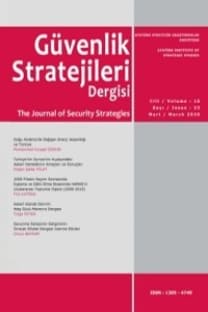China’s Smart Rise
Çin’in Akıllı Yükselişi
___
- MORGENTHAU Hans J., Politics Among Nations: the Struggle for Power and Peace, McGraw Hill, Boston MA, 1993.
- NYE Joseph S. Jr., Power in the Global Information Age: From Realism to Globalization, Routledge, New York, 2005.
- ZHU Zhiqun, China’s New Diplomacy: Rationale, Strategies and Significance, Ashgate, Surrey, 2010.
- BALDWIN David A., “Power and International Relations,” Handbook of International Relations, edited by Walter Carlsnaes, Thomas Risse and Beth A. Simmons, Sage Publications, London, 2002.
- SHAMBAUGH David, “China’s Military Views the World: Ambivalent Security,” The Rise of China, edited by Michael E. Brown, et al., MIT Press, Cambridge, 2000.
- BECKLEY Michael, “China’s Century? Why America’s Edge Will Endure,” International Security, 2011/12, Vol: 36, No. 3.
- DING Sheng, “Analyzing Rising Power from the Perspective of Soft Power: a New Look at China’s Rise to the Status Quo Power,” Contemporary China, 2010, Vol: 19, No. 64.
- GLASER Bonnie S. and Medeiros Evan S., “The Changing Ecology of Foreign Policy-Making in China: The Ascension and Demise of the Theory of ‘Peaceful Rise,” China Quarterly, 2007, Vol: 190, http://tailieu. tapchithoidai.org/Demise_of_Peaceful_Rise.pdf (Access date: 22.03.2013).
- HUANG Yanzhong and Sheng Ding, “Dragons’ Underbelly: An Analysis of China’s Soft Power,” EAST ASIA, 2006, Vol: 23.
- LAM Willy, “Beijing’s Aggressive New Foreign Policy and Implications for the South China Sea,” China Brief, 2013, Vol: 13, No. 13, http://www.jamestown.org/uploads/media/cb_08_09.pdf (Access date: 28.06.2013).
- PARAMESWARAN Prashanth, “Sino-Indian Border Negotiations: Problems and Prospects,” China Brief, 2012, Vol: 12, No. 6, http://www.jamestown.org/uploads/media/cb_03_06.pdf (Access date: 28.04.2013).
- RYOU Hayoun Jessie, “The Meaning of China’s ‘Peaceful Development’ Concept,” Observer Research Foundation Occasional Paper 2009, Vol: 3, No. 12.
- SHAMBAUGH David, “International Relations Studies in China: History, Trends, and Prospects,” International Relations of the AsiaPacific, Vol: 11, No. 3.
- SWANE Michael D., “China’s Assertive Behaviour Part Three: The Role of the Military in the Foreign Policy,” China Leadership Monitor, 2011, No. 36, http://carnegieendowment.org/files/ Swaine_CLM_363.pdf (Access date: 25.03.2013).
- WALTZ Kenneth N. “The Emerging Structure of International Politics.” International Security, 1993, Vol: 18, No. 2.
- “Asia’s Balance of Power: China’s Military Rise,” Economist, 7 April 2012, http://www.economist.com/node/21552212 (Access date: 26.04.2013).
- BIJIAN Zheng, “China’s Peaceful Rise: Implications for Domestic Development and International Relations,” East Asian Visions: Perspectives on Economic Development, 2006, http://siteresources. worldbank.org/INTEASTASIAPACIFIC/Resources/226262-11582628 34989/EA_Visions_18.pdf (Access date: 14.04.2013).
- BRISTOW Michael, “Who Writes China Leader’s Wen Jiabao’s Annual Speech,” BBC News, 5 March 2011, http://www.bbc.co.uk/ news/world-asia-pacific-12548685 (Access date: 02.03.2013).
- CCTV/CNTV, http://english.cntv.cn/01/index.shtml (Access date: 24.06.2013).
- China’s Foreign Aid, White paper, 21 April 2011, http://www.euchina.net/web/cms/upload/pdf/nachrichten/2011-04-21Chinas-Foreign Aid-WhitePaper.pdf (20.03. 2013).
- “China’s National Defense in 2010,” White Paper, 31 March 2011, http://www.china.org.cn/government/whitepaper/node_7114675.htm (Access date: 23.03.2013).
- China’s Peaceful Rise: Speeches of Zheng Bijian 1997-2004, http://www.brookings.edu/fp/events/20050616bijianlunch.pdf (Access date: 25.04.2013).
- China International Publishing Group (CIPG), “Overview,” http://www.cipg. com.cn/about_cipg/overview/ (Access date: 12.03.2013).
- “China’s Central Bank Becomes World’s Biggest in Total Assets: Standard Chartered,” Caijing, 23 April 2012, http://english.caijing.com.cn/ 2012-04-23/111823281.html (Access date: 25.04.2013).
- “China’s Military Rise, Dragon’s New Teeth: a Rare Look Inside the World’s Biggest Military Expansion,” Economist, 7 April 2012, http://www.economist.com/node/2152193 (Access date: 12.04.2013).
- COUGHLAN Sean, “Record Numbers of International Students”, BBC News, 10 March 2011, BBC News, http://www.bbc.co.uk/news/ business-12671198 (Access date: 20.03.2013).
- “Daily Chart: The Dating Game,” Economist, 27 December 2011, http://www.economist.com/blogs/dailychart/2010/12/save_date (Access date: 30.03.2013)
- “Defense Expenditure,” Ministry of National Defense of the People’s Republic of China, http://eng.mod.gov.cn/Database/Expenditure/ index.htm (Access date: 24.04.2013).
- “Full Text of Xi Jinping's Speech at Opening Ceremony of Boao Forum,” People’s Daily Online, 8 April 2013, http://english.people daily.com.cn/102774/8198392.html (Access date: 20.05.2013).
- “GDP Forecast,” Economist, 21 April 2012, http://www.economist. com/node/21553046 (Access date: 25.04.2013). Hanban, “Confucius Institute Headquarters,” http://english.hanban.org/ node_7716.htm (Access date: 22.03.2013).
- “Health Diplomacy: In Africa, China’s Soft Power Provides a Healing Touch,” Arabic Knowledge@Wharton, 22 November 2011, http://knowledge.wharton.upenn.edu/arabic/article.cfm?articleid=2748 (Access date: 25.03.2013).
- JIABAO Wen, “Towards the Attainment of Millennium development Goals,” (statement at the Un High-Level Plenary Meeting on the Millennium development Goals, New York, the US, 22 September 2010), http://www.un.org/en/mdg/summit2010/debate/CN_en.pdf (Access date: 24.03.2013).
- JIA Qingguo, “Continuity and Change: China’s Attitude toward Hard Power and Soft Power,” Brookings NorthEast Asia Commentary, 2010, http://www.brookings.edu/opinions/2010/12_china_soft_ power_jia.aspx (Access date: 28.03.2013).
- MAAHBUBANI Kishore, “Smart Power, Chinese Style,” American Interest, March/April 2008, http://www.the-americaninterest.com/article-bd.cfm?piece=406 (Access date: 22.04.2013).
- NYE Joseph S. Jr., “The War on Soft Power,” Foreign Policy, 12 April 2011, http://www.foreignpolicy.com/articles/2011/04/12/ the_war_on_soft_power?page=full (Access date: 15.12. 2013).
- QING Yuan and Ronald SSEKANDI, “Africans Hold Own View on Chinese Aid,” Xinhuanet, 21 August 2011, http://news.xinhuanet.com/ english2010/indepth/2011-08/21/c_131064221.htm (Access date: 26.03.2013).
- Smile Diplomacy Working Magic Along China’s Periphery,” Economist, 29 March 2007, http://www.economist.com/node/8880901 (Access date: 20.04.2013).
- WAY Lingling and Bob Davis “China to name a Leader for Development Bank,” Wall Street Journal, 12 April 2013, http://online.wsj.com/article/SB1000142412788732374100457841827 3283766076.html (Access date: 21.06.2013)
- YECHENG Le, “The Rapid Development of China’s Diplomacy in a Volatile World,” (address delivered at the Seminar on China’s Diplomacy in 2011 and its Prospect, 18 December 2011), http://www.fmprc. gov.cn/eng/zxxx/t890675.htm (Access date: 25.04.2013).
- YING Wang, “Foreign Student Quota to Expand,” China Daily, 28 July 2008, http://www.chinadaily.com.cn/china/2008-07/29/ content_ 6884445.htm (Access date: 20.04.2013).
- ISSN: 1305-4740
- Yayın Aralığı: 3
- Başlangıç: 2005
- Yayıncı: Millî Savunma Üniversitesi Atatürk Stratejik Araştırmalar ve Lisansüstü Eğitim Enstitüsü
Mısır ve Tunus: Devrime Giden Süreçte Goldstone'un İddialarına Yönelik Deneme Alanları
AVRUPA BİRLİĞİ SİYASİ BİR CÜCE, ASKERİ BİR SOLUCAN MI?
Mısır ve Tunus: Devrime Giden Süreçte Goldstone'un İddialarına Yönelik Deneme Alanları
Mısır ve Tunus: Devrime Giden Süreçte Goldstone’un İddialarına Yönelik Deneme Alanları
Batılı Koloniyel Güçlerin 1994 Ruanda Soykırımına Etkisi
Siber Güvenliğin Milli Güvenlik Açısından Önemi ve Alınabilecek Tedbirler
